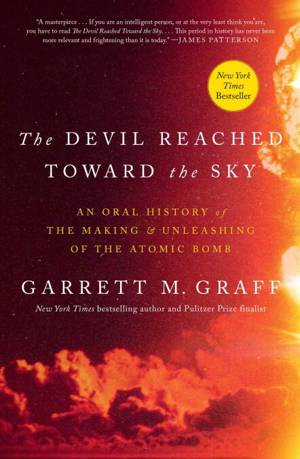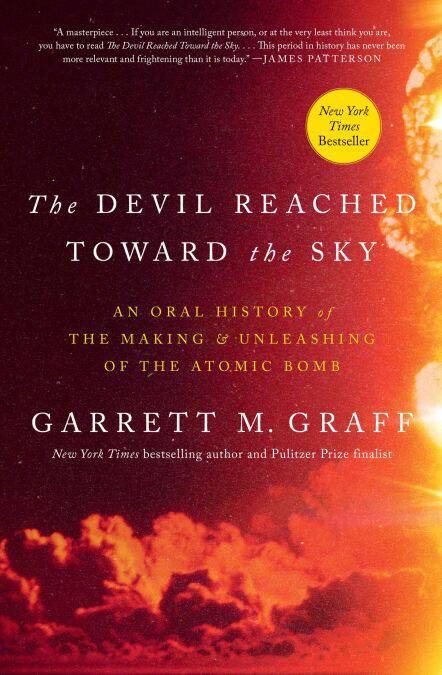
- Retrait gratuit dans votre magasin Club
- 7.000.000 titres dans notre catalogue
- Payer en toute sécurité
- Toujours un magasin près de chez vous
- Retrait gratuit dans votre magasin Club
- 7.000.0000 titres dans notre catalogue
- Payer en toute sécurité
- Toujours un magasin près de chez vous
The Devil Reached Toward the Sky EBOOK
An Oral History of the Making and Unleashing of the Atomic Bomb
Garrett M. Graff
Ebook | Anglais
19,00 €
+ 19 points
Description
NEW YORK TIMES BESTSELLER • “Magisterial…A stunning account that brings to the fore the nuclear saga’s surreal combination of ingenuity, fate, and terror.” —Publishers Weekly (starred review) • “If you are an intelligent person, or at the very least think you are, you have to read The Devil Reached Toward the Sky…This period in history has never been more relevant and frightening than it is today.” —James Patterson • “Comprehensive and engrossing…Excellent oral history.” —Kirkus Reviews
On the 80th anniversary of the Hiroshima and Nagasaki bombings, the Pulitzer Prize finalist whose work is “oral history at its finest” (Pittsburgh Post-Gazette) delivers an epic narrative of the atomic bomb’s creation and deployment, woven from the voices of hundreds of scientists, generals, soldiers, and civilians.
The building of the atomic bomb is the most audacious undertaking in human history: a rush by a small group of scientists and engineers in complete secrecy to unlock the most fundamental power of the universe. Even today, the Manhattan Project evokes boldness, daring, and the grandest of dreams: bringing an end to World War II in the Pacific. As Marines, soldiers, sailors, and airmen fight overseas, men and women strive to discover the atom’s secrets in places like Chicago, Berkeley, Oak Ridge, Hanford, and Los Alamos. On August 6, 1945, the world discovers what the end of the war—and the new global age—will look like.
The road to the first atomic bomb ends in Hiroshima, Japan, but it begins in Hitler’s Europe, where brilliant physicists are forced to flee fascism and antisemitism—bringing to America their determination to harness atomic power before it falls into the Führer’s arsenal. The Devil Reached Toward the Sky traces the breakthroughs and the breakneck pace of atomic development in the years leading up to 1945, then takes us inside the B-29 bombers carrying Little Boy and Fat Man and finally to ground zero at Hiroshima and Nagasaki.
From Pulitzer Prize finalist Garrett M. Graff, The Devil Reached Toward the Sky is the panoramic narrative of how ordinary people grapple with extraordinary wartime risks, sacrifices, and choices that will transform the course of history. Engineers experiment with forces of terrifying power, knowing each passing day costs soldiers’ lives—but fearing too the consequences of their creation. Hundreds of thousands of workers toil around the clock to produce uranium and plutonium in an endeavor so classified that most people involved learn the reality of their effort only when it is announced on the radio by President Truman. The 509th Composite Group trains for a mission whose details are kept a mystery until shortly before takeoff, when the Enola Gay and Bockscar are loaded with bombs the crew has never seen. And the civilians of two Japanese cities that have been spared American attacks—preserved for the sake of judging the bomb’s power—escape their pulverized homes into a greater hellscape.
Drawing from dozens of oral history archives and hundreds of books, reports, letters, and diaries from across the US, Japan, and Europe, Graff masterfully blends the memories and perspectives from the known and unknown—key figures like J. Robert Oppenheimer, General Leslie Groves, and President Truman; the crews of the B-29 bombers; and the haunting stories of the Hibakusha—the “bomb-affected people.” Both a testament to human ingenuity and resilience and a compelling drama told by the participants who lived it, The Devil Reached Toward the Sky is a singular, profound, and searing book about the inception of our most powerful weapon and its haunting legacy.
On the 80th anniversary of the Hiroshima and Nagasaki bombings, the Pulitzer Prize finalist whose work is “oral history at its finest” (Pittsburgh Post-Gazette) delivers an epic narrative of the atomic bomb’s creation and deployment, woven from the voices of hundreds of scientists, generals, soldiers, and civilians.
The building of the atomic bomb is the most audacious undertaking in human history: a rush by a small group of scientists and engineers in complete secrecy to unlock the most fundamental power of the universe. Even today, the Manhattan Project evokes boldness, daring, and the grandest of dreams: bringing an end to World War II in the Pacific. As Marines, soldiers, sailors, and airmen fight overseas, men and women strive to discover the atom’s secrets in places like Chicago, Berkeley, Oak Ridge, Hanford, and Los Alamos. On August 6, 1945, the world discovers what the end of the war—and the new global age—will look like.
The road to the first atomic bomb ends in Hiroshima, Japan, but it begins in Hitler’s Europe, where brilliant physicists are forced to flee fascism and antisemitism—bringing to America their determination to harness atomic power before it falls into the Führer’s arsenal. The Devil Reached Toward the Sky traces the breakthroughs and the breakneck pace of atomic development in the years leading up to 1945, then takes us inside the B-29 bombers carrying Little Boy and Fat Man and finally to ground zero at Hiroshima and Nagasaki.
From Pulitzer Prize finalist Garrett M. Graff, The Devil Reached Toward the Sky is the panoramic narrative of how ordinary people grapple with extraordinary wartime risks, sacrifices, and choices that will transform the course of history. Engineers experiment with forces of terrifying power, knowing each passing day costs soldiers’ lives—but fearing too the consequences of their creation. Hundreds of thousands of workers toil around the clock to produce uranium and plutonium in an endeavor so classified that most people involved learn the reality of their effort only when it is announced on the radio by President Truman. The 509th Composite Group trains for a mission whose details are kept a mystery until shortly before takeoff, when the Enola Gay and Bockscar are loaded with bombs the crew has never seen. And the civilians of two Japanese cities that have been spared American attacks—preserved for the sake of judging the bomb’s power—escape their pulverized homes into a greater hellscape.
Drawing from dozens of oral history archives and hundreds of books, reports, letters, and diaries from across the US, Japan, and Europe, Graff masterfully blends the memories and perspectives from the known and unknown—key figures like J. Robert Oppenheimer, General Leslie Groves, and President Truman; the crews of the B-29 bombers; and the haunting stories of the Hibakusha—the “bomb-affected people.” Both a testament to human ingenuity and resilience and a compelling drama told by the participants who lived it, The Devil Reached Toward the Sky is a singular, profound, and searing book about the inception of our most powerful weapon and its haunting legacy.
Spécifications
Parties prenantes
- Auteur(s) :
- Editeur:
Contenu
- Nombre de pages :
- 608
- Langue:
- Anglais
Caractéristiques
- EAN:
- 9781668092415
- Date de parution :
- 04-08-25
- Format:
- Ebook
- Protection digitale:
- Adobe DRM
- Format numérique:
- ePub

Les avis
Nous publions uniquement les avis qui respectent les conditions requises. Consultez nos conditions pour les avis.






